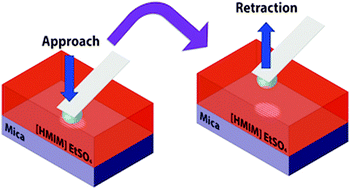Irreversible structural change of a dry ionic liquid under nanoconfinement†
Abstract
Studies of 1-hexyl-3-methyl-imidazolium ethylsulfate ([HMIM] EtSO4) using an extended surface forces apparatus show, for the first time, an ordered structure within the nanoconfined ionic liquid (IL) between mica surfaces that extends up to ∼60 nm from the surface. Our measurements show the growth of this ordered IL-film upon successive nanoconfinements—the structural changes being irreversible upon removal of the confinement—and the response of the structure to shear. The compressibility of this system is lower than that typically measured for ILs, while creep takes place during shear, both findings supporting a long-range liquid-to-solid transition. AFM (sharp-tip) studies of [HMIM] EtSO4 on mica only reveal ∼2 surface IL-layers, with order extending only ∼3 nm from the surface, indicating that confinement is required for the long-range IL-solidification to occur. WAXS studies of the bulk IL show a more pronounced ordered structure than is the case for [HMIM] with bis(trifluoromethylsulfonyl)imide as anion, but no long-range order is detected, consistent with the results obtained with the sharp AFM tip. These are the first force measurements of nanoconfinement-induced long-range solidification of an IL.


 Please wait while we load your content...
Please wait while we load your content...